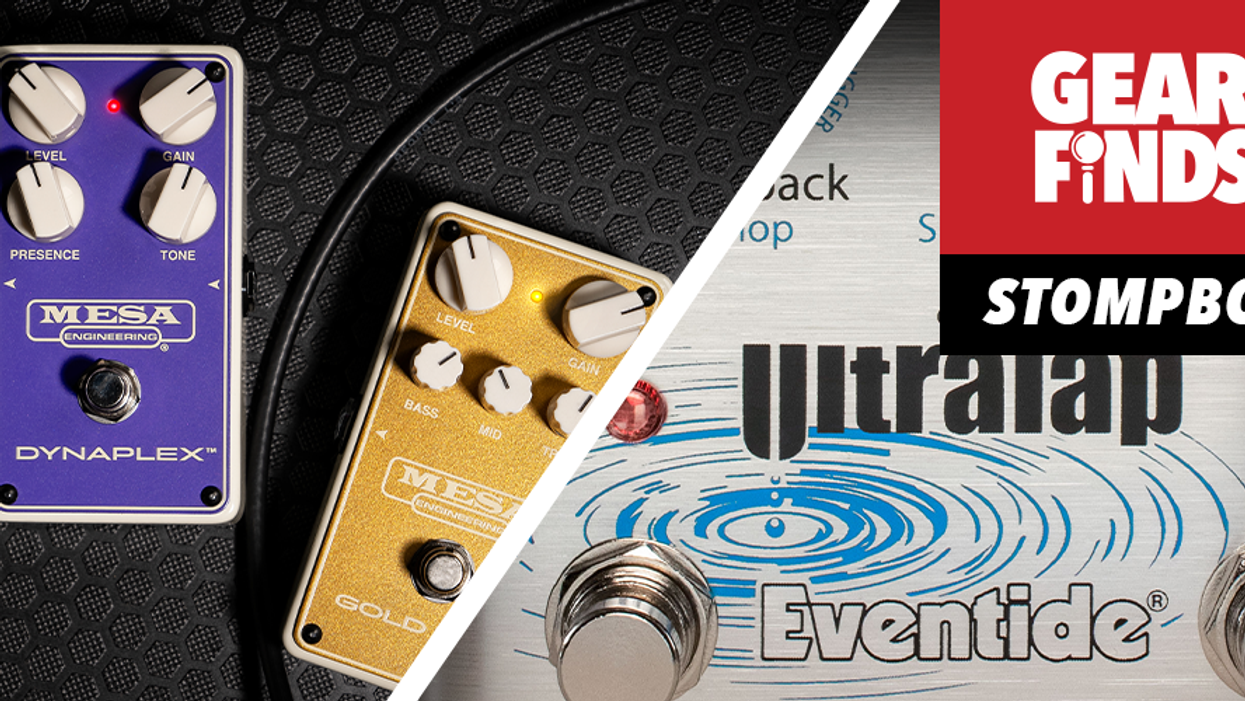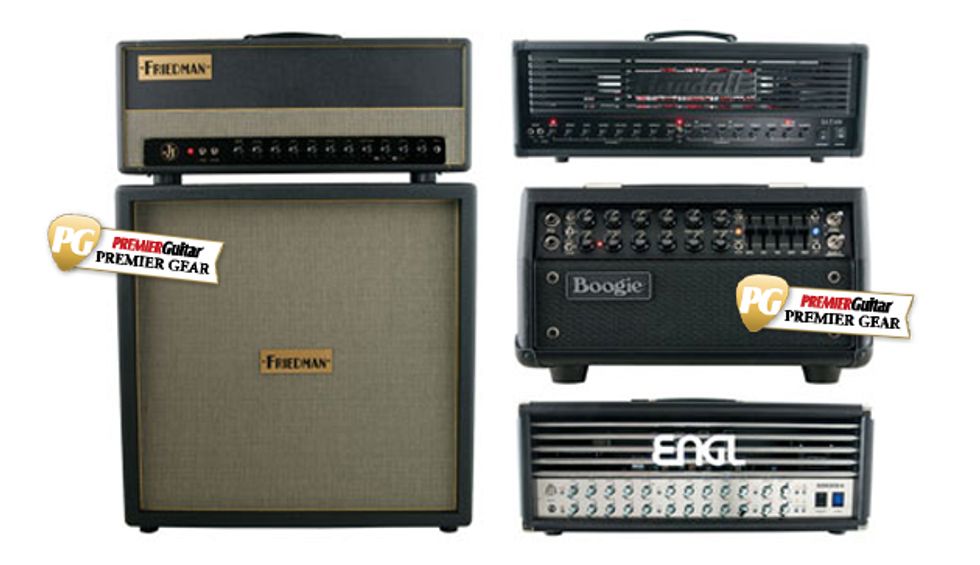
Since Hendrix, Cream, and the Who signaled the dawn of 100-watt-driven heavy music, hard rock and metal guitarists have coveted tools for pushing the boundaries in genres where subtlety rarely matters. In the old days, there weren’t too many heavy amp merchants—Orange, Marshall, and Laney were about it for a long time.
Fast-forward to present day. Rock and metal guitarists now have more options than ever to sate their jones for all things heavy. The sea of choices means the biggest problem isn’t whether the ideal amp exists, but which one will deliver the goods.
With the hope of making your own quest for heavy a little easier, we’ve compiled a roundup of four monstrously heavy amplifiers—the Randall Satan Ola Englund signature model, Engl Invader II E642/2, the tiny but terrifying Mesa/Boogie Mark Five: 25, and the Friedman Double J Jerry Cantrell signature model. Each one delivers monstrously heavy tone in unique ways, underscoring just how many cool options now exist in this realm.
Click on the amp you want to learn about and hear in action or click next to read about them all!
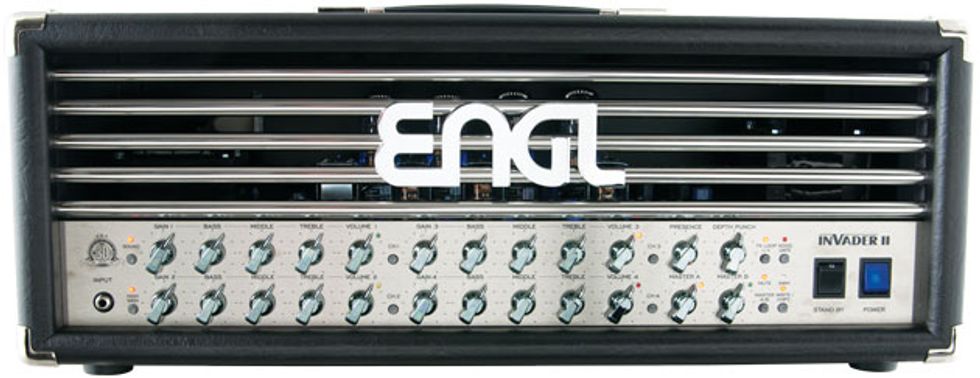
Engl Invader II E642/2
Key Features- Tubes: Four EL34 power tubes, four 12AX7 preamp tubes.
- Output: 100 watts at 4, 8 or 16 ohms.
- Channels: Four completely independent channels for clean, crunch, rhythm, and lead.
- Controls: Channel-specific 3-band EQ, gain and volume knobs, high/low gain switches with volume balancers and switchable, programmable alternate voicing modes, dual master volumes with presence and depth controls.
- Additional Features: Adjustable noise gate, two series/parallel effects loops, tuner out jack, power tube monitoring and protection, MIDI programmable, jacks for both Engl and MIDI footswitches.
The jack-of-all-trades Invader II takes the discrete, 4-channel design of its predecessor and refines it. Four EL34 tubes generate 100 watts of power, while four 12AX7 tubes drive the preamp. Each of its four uniquely voiced channels—clean, crunch, rhythm, and lead—sport their own dedicated gain, volume, and EQ controls, switchable gain boosting, and a “Sound” switch for choosing alternate modes that can be reprogrammed with different voicings.
The modes can be programmed via the amp’s optional Sound Wizard module ($399) on the back panel. There are 12 mini DIP switches for each channel that can alter bass and midrange response, and manage volume attenuation. And if the thought of fiddling with 84 DIP switches seems like it’s more trouble than it’s worth, the module can be switched off entirely.
There are also two separately adjustable master volumes, as well as global presence and depth controls, individual volume balancing controls for each channel’s high- and low-gain modes, two series/parallel effects loops with send level controls, a programmable noise gate, MIDI programmability, internal power tube monitoring and protection, jacks for Engl’s Z 4, Z 9, and MIDI footswitches, and speaker outputs for 4-, 8- and 16-ohm cabinets.
Ratings
Pros:
More versatility than most will need or ever ask for. Cleans are warm and balanced. Overdrive is smooth, thick and massive-sounding.
Cons:
The sheer number of knobs and switches can feel a little overwhelming. Expensive.
Tones:
Ease of Use:
Build/Design:
Value:
Street:
$3,199
Engl Invader II E642/2
englamps.de
With a Les Paul Custom driving the input, the Invader II’s first channel delivers crisp, full-bodied clean tones with outstanding balance. Overall, the tones sound very even and pack quite a wallop. The stock mode’s smooth-as-silk voicing makes it hard to coax Fender Twin-like jangle, but that’s attainable if you press the Sound switch to access the second mode and use the channel’s Sound Wizard DIP switches to dial in the tones you’re after.
The second channel turns up the heat and dishes smooth-yet-greasy overdrive with a brawny British-style midrange. Even in its low-gain mode, there’s plenty of gain on tap for the needs of most rock and blues players. Forceful single-note picking squeezes out an authoritative Page-like quack in the highs, and lighter picking emphasizes mid-focused grind. Flipping to the high-gain mode unleashes thick, succulent overdrive that works for ’80s hair-metal riffing in the vein of Blizzard of Oz and Shout at the Devil.
Channel 3 picks up where the second leaves off gain-wise, but with a more modern and aggressive voicing. Boasting a throaty midrange and a thick, rock-solid bottom end, the amp’s intense and velvety overdrive is one of the finest sounds Engl has ever delivered. Using a Les Paul with the EQ slightly scooped and the gain at 1 o’clock, the note separation and low-end clarity are astoundingly good. In this channel’s high-gain mode, the Sound Wizard’s bright switch adds bite to the top end for aggressive metal rhythms, à la Slayer.
The amp’s fourth channel delivers torrents of liquid gain with a heavy emphasis on the upper midrange. The fluid sustain makes this channel a perfect match for lightning-fast legato leads and phrases. Channel 4 has an obscene amount of gain on tap—even in its low-gain mode—so it’s essential to be mindful of where the control is set to avoid congestion. The amp’s adjustable noise gate really comes in handy for cutting down the hiss from the channel’s high-gain mode, and its gating clamps down very naturally when the strings are muted.
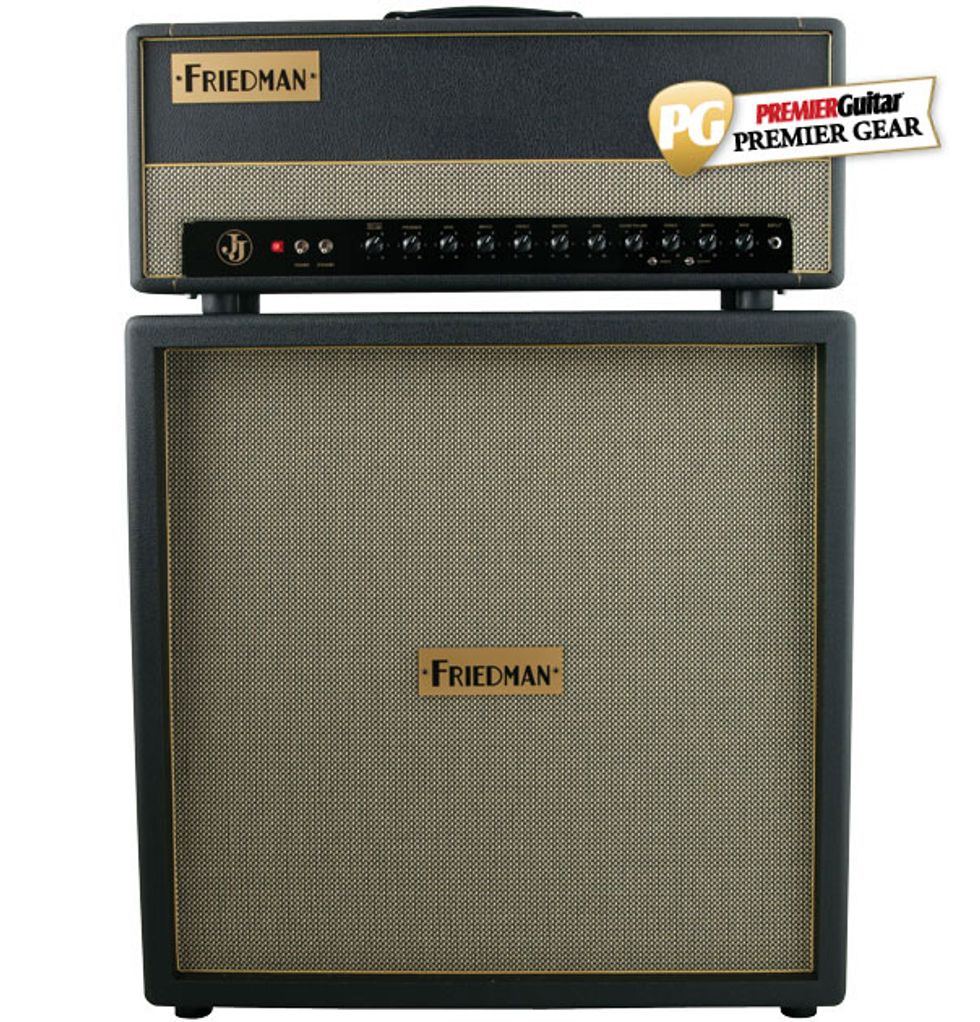
Friedman Double J Jerry Cantrell
Key Features- Tubes: Four EL34 power tubes, four 12AX7 preamp tubes.
- Output: 100 watts.
- Channels: Clean and dirty.
- Controls: Dedicated 3-band EQ and controls for preamp gain and channel volume on each channel, 3-way brightness switch for clean channel, presence and JBE Brown Eye mode switch for dirty channel, global master volume control.
- Additional Features: Tube-driven serial effects loop, line out jack with level adjustment, two speaker outputs with 4-, 8-, and 16-ohm options.
The Double J amplifier is the result of a partnership between Alice in Chains guitarist Jerry Cantrell and boutique amp engineer/Rack Systems founder David Friedman. Cantrell was one of the first artists to join Friedman’s roster of endorsees, using some of the earliest versions of the Brown Eye head for touring in support of 2009’s Black Gives Way to Blue, as well as for 2012’s The Devil Put Dinosaurs Here.
Cantrell has never been one for complicated rigs, and the Double J’s straightforward design reflects that mindset. The 100-watt power section is fueled by a quartet of EL34s, and sitting at the heart of the amp’s dual-channel preamp section are four 12AX7 preamp tubes. The amp is voiced for Friedman’s Vintage 4x12 16-ohm cabinet that’s loaded with two Celestion G12M Greenbacks on top and two Celestion Vintage 30s on the bottom for stronger projection.
Ratings
Pros:
Highly responsive and easy to use. Spectacular three-dimensional cleans. Arguably some of the richest and most complex British high-gain overdrive tones available.
Cons:
Expensive. Using the JBE mode robs volume without an optional mod.
Tones:
Ease of Use:
Build/Design:
Value:
Street:
$3,699 (head) and $1,199 (cabinet)
Friedman Double J Jerry Cantrell
friedmanamplification.com
Channel 1 is tailored for clean tones and has its own 3-band EQ, gain and volume controls, and a 3-way brightness switch. Channel 2 is a customized Brown Eye channel with a 3-band EQ and knobs for gain, volume, and presence. A master volume governing both channels sits at the far left on the front panel. Flipping the rear-panel “JBE” switch activates Cantrell’s custom distortion circuit, which adds more saturation and gain, and a tighter bass response. The back panel also has a serial effects loop and line out with adjustable level control.
With a Les Paul Custom, the Double J’s cleans have velvety-smooth highs that are supported by a woody midrange and blooming lows. Raising the treble knob past 2 o’clock introduces a bristling Vox-like edge to the attack, and pulling back the midrange to 10 o’clock yields a clear, authoritative tone that’s perfect for gloomy arpeggiated progressions.
Unlike treble controls used for clean channels on many other high-gain amps, turning the knob up seems to thicken the highs instead of thinning them out, and this is helpful for copping full-bodied plexi-esque cleans at lower volumes. And the brightness switch does a brilliant job of adding a perfect amount of harmonic complexity to the highs—a very useful tool for livening up dark-sounding pickups.
Fans of Cantrell’s distinctively chewy and gargantuan tones will not be disappointed by Channel 2’s thick distortion. The overdrive is absolutely flooring, and the note separation within full and complex chords is impressive too. With a Les Paul in dropped C# tuning, the bass and mid knobs at 2 o’clock, treble and gain at 3 o’clock, and a fierce-yet-controlled picking style, the amp easily delivers the hair-raising grind of Cantrell’s Dirt-era playing. Dialing back the bass, setting the presence to a little higher than 1 o’clock, and adjusting the gain to around 2 o’clock gets scarily close to the juicy, hot-rodded tone of the guitarist’s Facelift years.
The overdrive channel isn’t solely limited to delivering Cantrell’s ideal sounds. The channel cleans up exceptionally well if you dial back the guitar’s volume, and along the way it sweeps through a rich palette of throaty Marshall-flavored tones that are perfect for British blues and classic rock styles. On the other end of the spectrum, the channel’s responsive EQ and gobs of gain on tap enable seriously brutal modern rock and metal tones. The most intense of these happen when you flip the JBE switch, which not only adds just enough gain to push it over the edge, but a ruder and more aggressive voicing to the midrange. There’s an unfortunate volume drop (a Cantrell preference) that’s pretty noticeable when using this circuit, but for an additional fee, Friedman is happy to install an extra volume control to compensate for the loss.
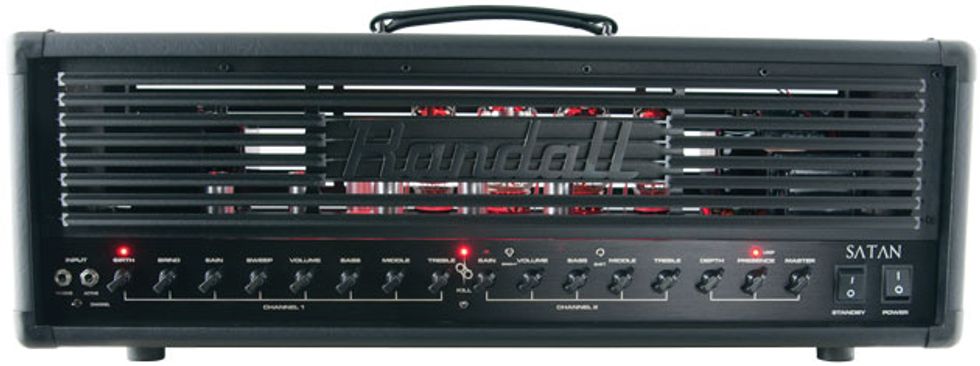
Randall Satan Ola Englund
Key Features- Tubes: Two 6L6 and two KT88 power tubes, six 12AX7 preamp tubes.
- Output: 120 watts.
- Channels: Overdrive and clean.?
- Controls: Dedicated 3-band EQ and controls for preamp gain and volume on each channel, mid-boost switch, sweep, bright and 3-way voicing switch for clean channel, “6irth” and “6rind” frequency controls for overdrive channel, master presence, depth, and volume.
- Additional Features: Series/parallel effects loop with send level adjustment, raw and cabinet-emulated line outputs, speaker outputs for single and multiple 4-, 8-, and 16-ohm cabinets.
The Satan is the result of a two-year collaboration between Swedish death metal master Ola Englund, renowned amp engineer Mike Fortin, and Randall Amplification. Its roots stretch to Englund’s Fortin Natas amp that he’s used for brutalizing listeners with Six Feet Under and The Haunted. With the sound and feel of that amp in mind, the Satan was designed from the ground up with a customized tone stack, gain structure, and EQ to suit Englund’s needs.
Two pairs of 6L6 and KT88 power tubes dish out 120 watts of bone-crushing power while illuminating the amp with a haunting crimson glow. Clean and dirty tones are processed via five 12AX7 preamp tubes. A sixth 12AX7 processes the signal of the amp’s series/parallel effects loop.
Ratings
Pros:
Pristine cleans and brilliantly voiced thrash metal overdrive. Gobs of headroom. Stays tight and focused with super-low tunings.
Cons:
Airtight lows and lightning-quick attack limit its usage to faster genres of metal, such as death and thrash.
Tones:
Ease of Use:
Build/Design:
Value:
Street:
$1,966
Randall Satan Ola Englund
randallamplifiers.com
Each channel has its own discrete gain, volume, and 3-band EQ controls, and is governed by master controls for presence, depth, and overall volume. The clean channel sports switches for added brightness and three selectable voicings. The gain channel features a “Kill” switch for boosting the upper mids, as well as knobs for changing the frequency sweep of the EQ. There’s also a cabinet-emulating XLR output with an unfiltered line out jack, multiple speaker outputs, and separate inputs for using passive or active pickups.
Judging from the amp’s name, it might come as a surprise that the Satan’s clean tones are actually quite good. Using a Les Paul Custom with the clean channel’s midrange scooped and the presence at 1 o’clock yields one hell of a crystal-clear tone. Flipping the bright switch allows even more fidelity and treble to pass through without adding any painful “squeak” to pick attack. The voicings shift between being more-or-less bass and mid focused, and both are extremely useable. Compared to something like a big blackface Fender, it’s pretty cold and stiff-sounding—but impressive for a metal-oriented amp.
The Satan’s gain channel is a thrash lover’s dream, and it’s easily one of the clearest and heaviest-sounding Randall has ever offered. With a Les Paul, the lows are both massive and consistently tight, regardless of how the EQ is set. In fact, its voicing is so tightly wound that introducing any sort of low end sag is next to impossible. While providing the overdrive plenty of headroom to breathe, the power amp’s 6L6/KT88 combo has the stopping power of a punch to the chest. The combination of all these qualities gives the Satan an uncommon capacity to handle the lower registers of dropped tunings and 7- and 8-string guitars.
The “6irth” and “6rind” gain-frequency controls function brilliantly and deliver a wide range of gut-wrenching distortion tones with minimal fuss. Instead of turning up the treble and presence for a razor-like edge—which, in a lot of cases, adds unwanted harshness and buzz—turning the “6rind” knob revoices the gain itself. This lets you introduce more treble before the EQ without the risk of your sound mutating into a can of bees. You can sweep from the early thrash tones of Trouble, Metallica, and Celtic Frost to unrelenting bowel-shaking tones in the vein of Meshuggah and Lamb of God. With that in mind, don’t expect to hide mistakes behind the Satan’s overflowing rivers of gain. This amp will not hide your mistakes, and requires a surgically precise picking hand to coax its tightest and most awesome metal tones.
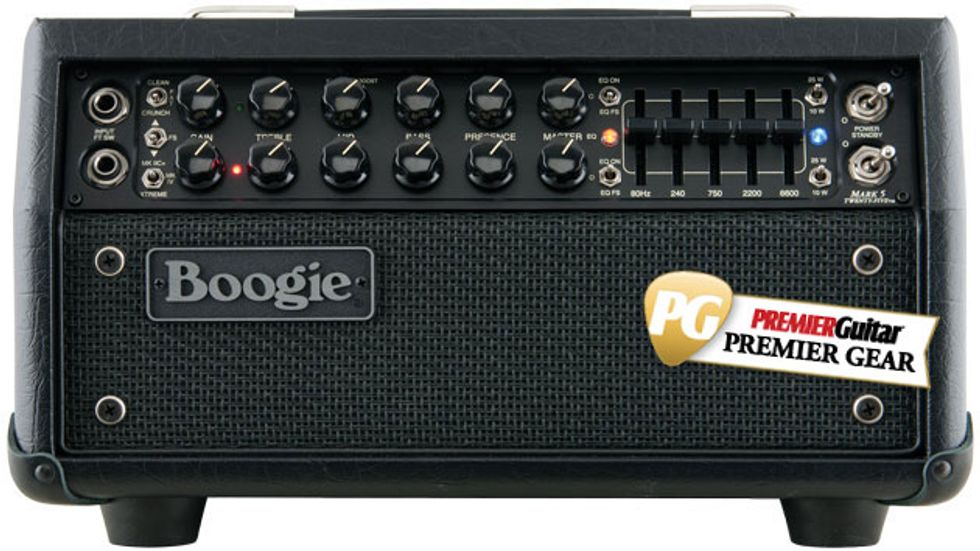
Mesa/Boogie Mark Five: 25
Key Features
- Tubes: Two EL84 power tubes, six 12AX7 preamp tubes.
- Output: Class AB Dyna-Watt power section with switchable wattage per channel to either 25 or 10 watts at 8 or 4 ohms.
- Channels: Clean and overdrive.
- Controls: Gain, treble, midrange, bass, and volume for each channel. Clean channel midrange boost or cut. Channel-assignable graphic EQ. Separate reverb level and wattage selection for each channel.
- Additional Features: Spring reverb, footswitch jack (footswitch not included), CabClone XLR D.I. output, tube-driven serial FX loop.
The diminutive Mark Five: 25 packs much of the tone and features of Mesa’s flagship amplifier into a compact 16-pound package. The preamp’s six 12AX7 preamp tubes feed a two-EL84 power section for 25 watts of maximum power. The power amp is designed with Mesa’s Dyna-Watt technology, which allows each of the two channels to be set separately for either 25- or 10-watts of output. Mesa recommends pairing the head with their Mini Rectifier 1x12 cabinets, which are loaded with a Celestion Vintage 30 speaker.
For such a tiny amplifier, the Mark Five: 25 has a lot of tone-shaping features. Both channels sport dedicated 3-band EQ sections and controls for gain, presence, and volume (the only difference being that the clean channel uses a cut/boost mid control). There’s six voicing modes—Clean, Fat, and Crunch for the clean channel, and Mk. IIC+, Mk. IV, and Extreme for the gain channel—along with the company’s famous channel-assignable 5-band graphic EQ. There’s also a small spring reverb onboard, a stripped-down version of Mesa’s CabClone cabinet simulator, a serial effects loop, and a 1/4" headphone jack for late-night jamming.
Ratings
Pros:
Feature-laden and easy to set-and-forget. Gorgeous cleans and ripping overdrive.
Cons:
Extreme mode is easily congested with hotter pickups.
Tones:
Ease of Use:
Build/Design:
Value:
Street:
$1,399 (head) and $449 (cabinet)
Mesa/Boogie Mark Five: 25
mesaboogie.com
The Clean mode on the amp’s clean channel is one of the best sounding in the mini amplifier realm. With a Les Paul Custom, the tone is tight and precise with plenty of clarity and Fender-like sparkle, and the EQ controls are sensitive enough that even minor adjustments can have dramatic effects on the tone. Its short-tank spring reverb sounds surprisingly deep for its size, and its cavernous wail is sure to surprise a lot of players who are used to the cold-sounding emulated reverbs found on many other mini amps.
Flipping to the channel’s Fat mode infuses the tone with tubbier lows and round highs and raises the channel’s overall volume somewhat. It also gives the midrange a stronger presence in the mix. The boost and cut abilities of the channel’s mid knob have a much more pronounced effect on the amp’s punchiness in this mode. The Crunch mode is effectively a full-blown overdrive channel, and with the gain set above 2 o’clock, there’s more than enough gain for both classic and early hard rock. It also cleans up nicely by rolling down the volumes on both a Stratocaster and Les Paul.
Channel 2’s first mode delivers the searing overdrive first heard from one of Mesa’s most famous amps, the Mark IIC+. Switching on the graphic EQ with a scooped mid setting and placing the gain knob at 1 o’clock instantly recalls the tight, vicious snarl and lock-step cut of classic ’80s thrash metal like Metallica’s Ride the Lightning and Master of Puppets.
The Mk. IV mode adds a bit more gain and thickens the lows and mids, resulting in a sweeter tone with more sustain that makes playing fast runs feel effortless. Its smooth voicing and hyper-sensitive EQ also make it the most balanced and versatile gain mode of the three. With the gain at 2 o’clock, bass and treble at noon, and judicious use of the mid and presence controls, carving out brutally heavy and thick-bodied rhythms is relatively easy.
For real gain addicts, the Extreme mode piles on more overdrive than should be legal. When using a hot set of humbuckers, however, the trick is to use a conservative amount because dialing the control past 11 o’clock can muddy up the tone.








![Rig Rundown: Russian Circles’ Mike Sullivan [2025]](https://www.premierguitar.com/media-library/youtube.jpg?id=62303631&width=1245&height=700&quality=70&coordinates=0%2C0%2C0%2C0)










